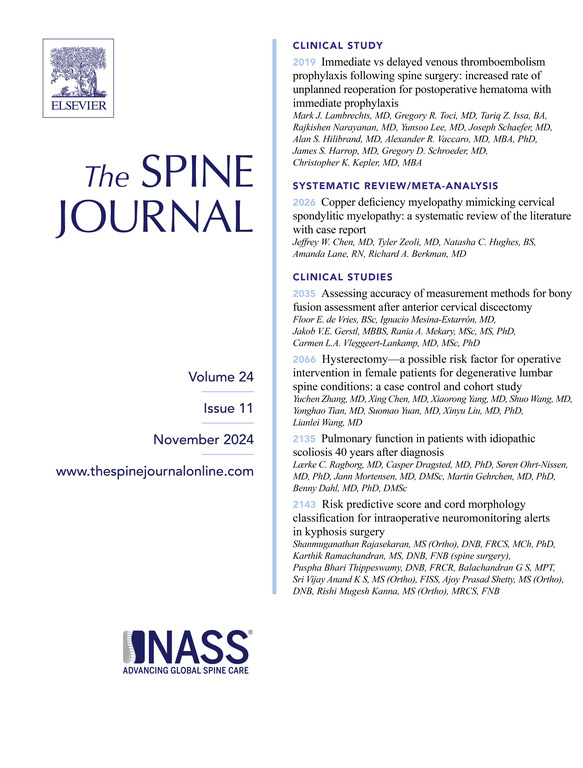在初步诊断为非特异性腰背痛后,与诊断特定腰椎病变相关的发病率、相关医疗机构和患者因素。
IF 4.7
1区 医学
Q1 CLINICAL NEUROLOGY
引用次数: 0
摘要
背景情况:腰背痛(LBP)是一种极为常见的诊断,给社会和医疗带来了沉重的负担。虽然非特异性腰背痛的诊断经常被指定,而且通常很快就会得到解决,但有些患者随后可能会被诊断出患有特定的潜在腰椎病变。研究目的:描述在最初的非特异性腰背痛(NS-LBP)诊断之后被诊断出患有特定病变的腰背痛(SP-LBP)的发生率、相关提供者和相关因素:研究设计:回顾性队列研究:研究设计:回顾性队列研究。患者样本:从大型国家行政数据库中抽取2010年至2022年第一季度被诊断为NS-LBP的成人患者:结果测量:在初次诊断为NS-LBP后的12个月内,后续SP-LBP诊断的发生率、涉及的医疗机构以及与SP-LBP诊断相关的因素:根据国际疾病分类(ICD)代码 ICD-9-D-724.2 和 ICD-10-D-M54.5 确定诊断为 NS-LBP 的成人患者。这些被诊断为新的 NS-LBP 患者的报告是基于每 10 万个受保人的发病率。排除标准包括:年龄小于 18 岁的患者、既往诊断为 NS-LBP 的患者、既往诊断为 SP-LBP 的患者,以及在初次诊断为 NS-LBP 之前 3 个月内诊断为外伤、肿瘤或感染的患者。然后,对在初次确诊 NS-LBP 后 12 个月内又确诊为 SP-LBP 的患者进行鉴定。根据年龄、性别、癌症病史、肥胖、阿片类药物使用障碍、焦虑和抑郁等因素对患者进行特征描述,然后通过单变量和多变量分析将其与未接受额外枸杞多糖诊断的患者进行比较。研究还确定了最初诊断为 NS-LBP 的医疗服务提供者以及随后诊断为 SP-LBP 的医疗服务提供者:在由 6,861,235 名患者组成的强大队列中发现了 NS-LBP,每 100,000 人中有 4,258 人被诊断为 NS-LBP。在 12 个月内,有 562,982 人(8.21%)被确诊为 SP-LBP,其中 62.57% 的 SP-LBP 诊断发生在 3 个月内。这些后续诊断中最常见的包括神经根病(占研究总人数的 3.01%)、椎间盘变性(2.84%)和椎间盘突出(1.23%)。接受后续 SP-LBP 诊断的患者更有可能年龄较大(每年增加,几率比 [OR] 1.02)、男性(OR 1.10)、有癌症病史(OR 1.32)、肥胖(OR 1.30)、阿片类药物使用障碍(OR 1.17)、焦虑(OR 1.21)或抑郁(OR 1.17)(P结论:NS-LBP 是一种常见的诊断,通常有 91.79% 的患者在 12 个月内不会转为 SP-LBP 诊断。这可能反映了枸杞多糖症状的改善和/或准确的初步分诊,主要是初级保健医生的分诊。在随后接受 SP-LBP 诊断的少数患者中,患者的各种因素有显著相关性,而且有更多的专科医疗人员参与其中,这突显了造成 SP-LBP 诊断困难的潜在因素以及 LBP 管理的多学科性质。本文章由计算机程序翻译,如有差异,请以英文原文为准。
The incidence, providers involved, and patient factors associated with diagnosis of specific lumbar spine pathology subsequent an initial nonspecific low back pain diagnosis
BACKGROUND CONTEXT
Low back pain (LBP) is an exceedingly common diagnosis with significant societal and healthcare burden. While nonspecific LBP diagnoses are frequently assigned and often resolve soon thereafter, some patients may subsequently be diagnosed with specific underlying lumbar spine pathology.
PURPOSE
To characterize the incidence, providers involved, and factors associated with specific pathology LBP (SP-LBP) diagnosed subsequent an initial nonspecific LBP (NS-LBP) diagnosis.
STUDY DESIGN
Retrospective cohort study.
PATIENT SAMPLE
Adult patients diagnosed with NS-LBP between 2010 and Q1 2022 were abstracted from a large national administrative database.
OUTCOME MEASUREMENTS
Incidence of subsequent SP-LBP diagnoses, providers involved, and factors associated with SP-LBP diagnoses in the 12-months following initial NS-LBP diagnosis.
METHODS
Adult patients diagnosed with NS-LBP were identified based on International Classification of Disease (ICD) codes ICD-9-D-724.2 and ICD-10-D-M54.5. These patients diagnosed with new NS-LBP were reported based on incidence per 100,000 covered lives. Exclusion criteria included: patients less than 18 years old, those with any prior NS-LBP diagnosis, any prior SP-LBP diagnoses, and those with trauma, neoplasm, or infection diagnosed within 3-months prior to the initial NS-LBP diagnosis. Patients who subsequently received SP-LBP diagnoses within 12-months following initial NS-LBP were then identified. Patients were characterized based on age, sex, history of cancer, obesity, opioid use disorder, anxiety, and depression and then compared with patients receiving no additional LBP diagnosis by univariable and multivariable analysis. Provider specialties who initially diagnosed NS-LBP and those involved with subsequent SP-LBP diagnoses were identified.
RESULTS
NS-LBP was identified for a robust cohort of 6,861,235 patients, yielding an incidence of 4,258 diagnoses per 100,000 covered lives. Subsequent SP-LBP diagnoses were identified for 562,982 (8.21%) within 12-months, of which 62.57% of these SP-LBP diagnoses occurred within 3-months. The most common of these subsequent diagnoses included radiculopathy (3.01% of the overall study population), disc degeneration (2.84%), and disc herniation (1.23%). Patients receiving a subsequent SP-LBP diagnosis were more likely older (per year increase, odds ratio [OR] 1.02), male (OR 1.10), had a history of cancer (OR 1.32), obesity (OR 1.30), opioid use disorder (OR 1.17), anxiety (OR 1.21), or depression (OR 1.17) (p<.001 for all). NS-LBP was initially diagnosed predominantly by primary care providers (PCPs) in family medicine (44.09%) and internal medicine (27.49%). These PCP providers also contributed to the majority of SP-LBP diagnoses, while specialty providers contributed to a greater degree in SP-LBP diagnoses than NS-LBP.
CONCLUSION
NS-LBP is a common diagnosis that usually, 91.79% of the time, does not subsequently convert to a SP-LBP diagnosis within 12-months. This may reflect improvement of LBP symptoms and/or accurate initial triage, largely by PCPs. Of the minority of patients receiving a subsequent SP-LBP diagnosis, various patient factors were significantly associated, and a greater degree of specialty providers were involved, which highlights potential contributors to diagnostic difficulty of SP-LBP and the multidisciplinary nature of LBP management.
求助全文
通过发布文献求助,成功后即可免费获取论文全文。
去求助
来源期刊

Spine Journal
医学-临床神经学
CiteScore
8.20
自引率
6.70%
发文量
680
审稿时长
13.1 weeks
期刊介绍:
The Spine Journal, the official journal of the North American Spine Society, is an international and multidisciplinary journal that publishes original, peer-reviewed articles on research and treatment related to the spine and spine care, including basic science and clinical investigations. It is a condition of publication that manuscripts submitted to The Spine Journal have not been published, and will not be simultaneously submitted or published elsewhere. The Spine Journal also publishes major reviews of specific topics by acknowledged authorities, technical notes, teaching editorials, and other special features, Letters to the Editor-in-Chief are encouraged.
 求助内容:
求助内容: 应助结果提醒方式:
应助结果提醒方式:


